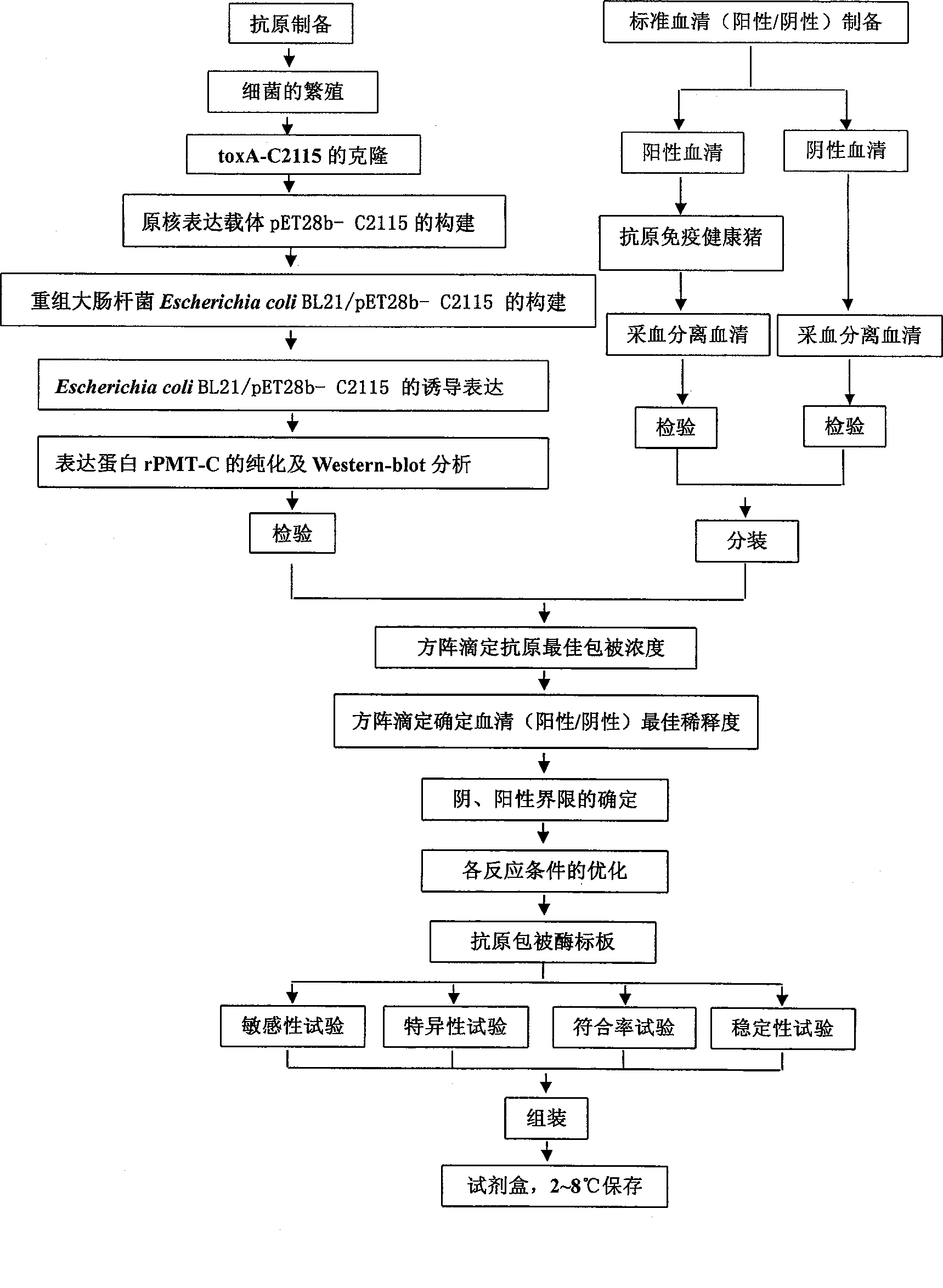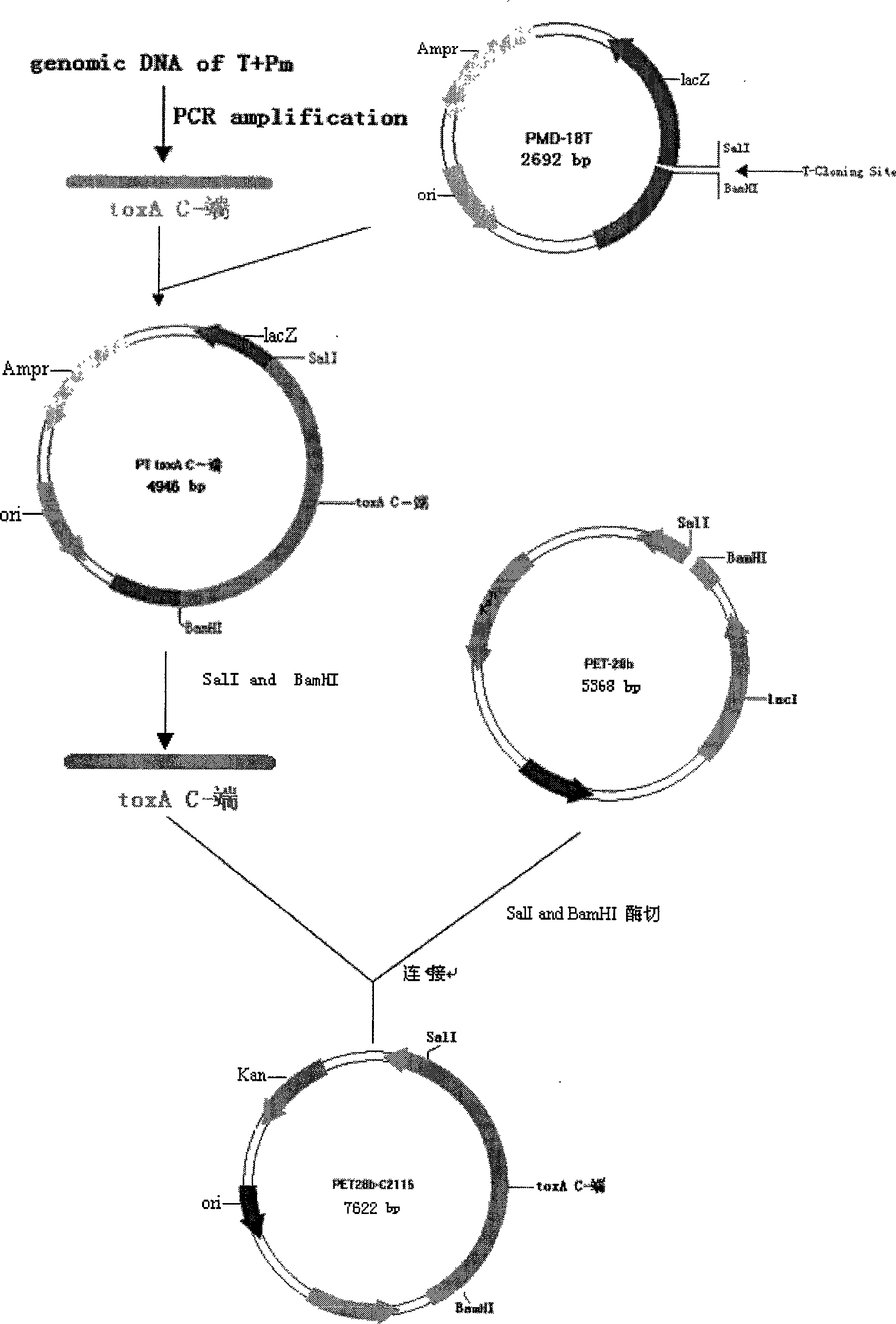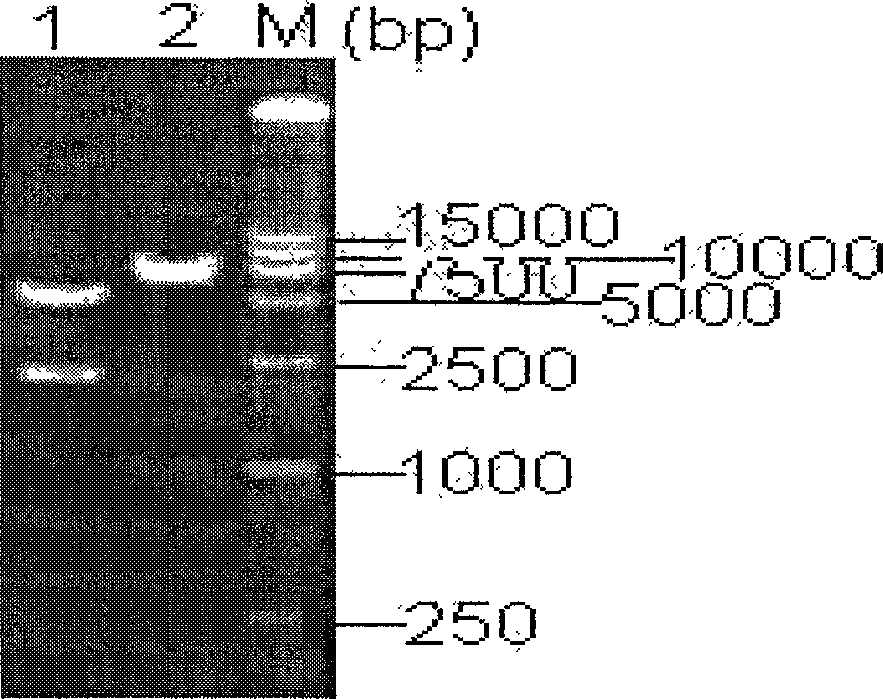ELISA kit for detecting porcine toxigenic pasteurella multocida toxin antibody and application
A Pasteurella multocida technology, which is applied in the field of ELISA kits for detecting swine toxin-producing Pasteurella multocida toxin antibodies, can solve the problem of not finding antibodies for detecting swine toxin-producing Pasteurella multocida toxins. ELISA kits, biological materials that cannot obtain core reagents, etc., achieve the effects of low production cost, high biological safety, and wide application prospects
- Summary
- Abstract
- Description
- Claims
- Application Information
AI Technical Summary
Problems solved by technology
Method used
Image
Examples
Embodiment 1
[0049] Example 1 Cloning of the C' end of the toxA gene of Pasteurella multocida
[0050] 1. Design of primers A pair of C’-terminal subcloning primers were designed with reference to the toxA gene sequence published on GenBank (accession number: Z28388). The primer sequences are as follows:
[0051] P 1 : 5’-TA G GAT CC T TTC CGT ATT GGA TTA G-3’
[0052] P 2 : 5’-AA G TCG AC T TAA GAA AGT TGT ATT GG-3'
[0053] Among them, the underlined parts of P1 and P2 represent the restriction sites of BamH I and Sal I, which were synthesized by Shanghai Sangon Bioengineering Technology Service Co., Ltd. The sequence amplified by the primers is 2257bp, of which the C' terminal coding region of the toxA gene is 2115bp, encoding the toxin r-PMT protein from the 580th amino acid to the terminator, a total of 705 amino acids.
[0054] 2. Cloning of the C' end of the toxA gene of the porcine toxin-producing Pasteurella multocida toxA
[0055] Toxigenic Pasteurella multocida was isol...
Embodiment 2
[0056] Example 2 Construction of the C'-terminal expression vector of the toxA gene of porcine toxin-producing Pasteurella multocida
[0057] The PCR product obtained in Example 1 was recovered, connected to the cloning vector pMD18-T (purchased from Treasure Bioengineering (Dalian) Co., Ltd.), transformed into Escherichia coli DH5α (purchased from Novagen), and screened for positive clones. Extract the plasmid, use restriction endonucleases BamH I and Sal I to double-digest and identify the recombinant plasmid, and use 0.8% agarose gel electrophoresis to confirm that its size is consistent with the expected target fragment size; it is confirmed by sequencing that the fragment has no bases Mismatched, containing the 2115bp sequence at the C' end of the toxA gene. The recombinant plasmid was named pT toxA-C2115.
[0058] Digest pT toxA-C2115 and vector pET28b with BamH I and Sal1 respectively, recover the C' end of toxA gene and vector pET28b; then connect with T4ligase, and t...
Embodiment 3
[0059] Example 3 Mass preparation of plasmid pET28b-C2115
[0060] (1) Pick the DH5α colony containing the plasmid pET28b-C2115 and inoculate it in 75mL LB culture medium, culture at 37°C 300r / min overnight, 6000rpm for 5min, collect the cell pellet, and use 3mL solution I (50mmol / L glucose, 10mmol / L ethylene glycol) Tetrasodium amine tetraacetate (EDTA), 25mmol / L Tris-Cl (pH8.0)) suspension;
[0061] (2) Add 6mL of solution II (0.2mol / L NaOH, 1% sodium dodecyl sulfate (SDS), ready to use), and ice-bath for 7-10min;
[0062] (3) Add 4.5mL solution III (3mol / L potassium acetate, adjust the pH value to 4.8 with glacial acetic acid), and ice-bath for 7-10min. 4℃10000r / min 10-15min;
[0063] (4) Take the supernatant, add 0.6 times the volume of isopropanol, mix well, and then 10000r / min for 6-15min at room temperature for 5min;
[0064] (5) Discard the supernatant, rinse once with 75% ethanol, vacuum dry or dry naturally, add 1.5mL TE (10.0mmol / LTris-HCl, 1.0mmol / L EDTA) to sus...
PUM
 Login to View More
Login to View More Abstract
Description
Claims
Application Information
 Login to View More
Login to View More - R&D
- Intellectual Property
- Life Sciences
- Materials
- Tech Scout
- Unparalleled Data Quality
- Higher Quality Content
- 60% Fewer Hallucinations
Browse by: Latest US Patents, China's latest patents, Technical Efficacy Thesaurus, Application Domain, Technology Topic, Popular Technical Reports.
© 2025 PatSnap. All rights reserved.Legal|Privacy policy|Modern Slavery Act Transparency Statement|Sitemap|About US| Contact US: help@patsnap.com



